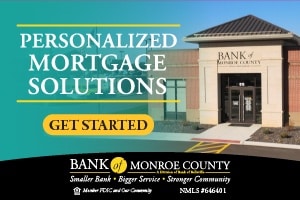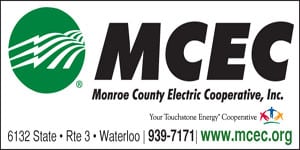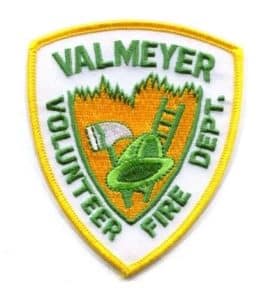Major changes coming to credit cards
Decades ago, people paid for purchases with cash or by writing checks. Today, cash is used only for small purchases, and it is almost impossible to find someone under the age of 50 who even knows how to write a check.
Today, most transactions take place with debit or credit cards, or even new smart phone apps.
In July, Republic-Times editor Corey Saathoff reported on a presentation on the new generation of credit cards – called “chip,” or “EMV” cards, to the Waterloo Chamber of Commerce. In his item, he indicated Oct. 1 as an important date in introduction of these new cards. So we asked a local banker, State Bank Senior Vice President Diane Ramey, about the new way of spending. Ramey said the new EMV cards should appear at her bank this fall.
“They will be issued for new or replacement cards,” she said. “People who want one will be able to get one. And perhaps at some future point, we will make blanketed issuances of large numbers.”
Most Americans assume we lead the world in financial transactions. However, we don’t. In fact, we are the last major country to adopt the EMV cards. The new cards incorporate technology agreed on by Europay International, MasterCard and Visa – thus the acronym “EMV.”
The new cards look much like the old ones – about 2 inches by 3.75 inches – but they include one significant new element, Ramey said, showing a card she already has. It has a rectangular, gold-colored device on the top, left front of the card. This is the “chip.”
When the card is used, unlike existing cards which are swiped through a slot in a reader, or stuck almost all the way into a slot on an ATM or gasoline purchase pump and quickly removed, it must be inserted into a slot in the reader and left there until the transaction is completed. In fact, a few readers will grip the card to prevent it from being removed prematurely.
When the card is in the reader, a unique code number is generated one time by the chip, and transmitted to the processor. That code number will not be used again. When the card is withdrawn, the code for the transaction is gone. Each time the EMV card is used, a new code is generated, transmitted and used by the processor to move money from your account to the merchant’s.
Older cards with strips are relatively easy to duplicate by people who want to use them to defraud your credit or bank balance. The new system relies on much higher tech, and will reduce fraud substantially. Long-time use worldwide has a proven track record.
In the process of introducing the new cards, there is also a change in the way liability issues are repaid. After the new equipment and system becomes operative on Oct. 1, liability for fraudulent use will shift to the person or firm using the lowest level technology – the merchant in most cases.
Many large businesses – so-called “box stores” and major chains — have already installed EMV card readers. These readers now will enable use of either older strip cards or the new chip, or EMV cards. Eventually, strips will disappear, according to State Bank’s Ramey.
“But that may take many years,” she acknowledged.
Replacing readers is a relatively small cost for other merchants, costing perhaps $200 or more, depending on the services provided by the reader. Merchants will have to weigh costs of dealing with fraudulent purchases and consequent charge backs, against the cost of the new readers. Some companies that provide the new readers and have a long-term relationship servicing clients may reduce the costs or even provide them free. The total cost of replacing credit-debit cards, readers and ATMs is estimated at $8.5 billion. But credit card fraud is also predicted by some to climb to $10 billion this year, so a large reduction in that problem will pay for the change.
Card readers in many locations may already have slots for EMV cards, but if the processing software has not been installed and implemented, they will not read cards via the slots. Those cards will still be swipable for some time.
Future developments will include ability to merely tap the cards on a reader to use them.
While some merchants are employing the new readers by Oct. 1, they will not be required on ATM machines until 2016, and on gasoline pumps until 2017. And indeed, some merchants – mainly smaller ones, may not be early adopters of this technology.
Jeff Fortney, of Clearent LLC, a, St. Louis-based national credit card processing firm, said adoption of the new cards may be somewhat slow at first. Perhaps about 20 to 30 percent of America’s 1.1 billion cards are EMV capable today, he indicated.
“Some large financial organizations are early adopters,” he said. “Bank of America and Chase Bank, along with Navy Federal Credit Union and USAA, are already issuing the cards,” he said.
Predictions point to as many as 58 percent of cards here being EMV compliant by year’s end, with complete U.S. market penetration by 2018.
Possible issues with non-card present purchases, such as on the internet and over phones, are being worked on, Fortney said. “And I expect the process to be able to accommodate tipping in restaurants within a few months,” he added.
He advised users, “This is a new process – a learning one too. Pay attention, follow instructions and be patient.” He added, “they will reduce fraud and that’s good for everyone.”
So in the meantime, what’s in it for Republic-Times readers with the new cards? They will be less subject to fraud. They will be more readily accepted if you travel out of the United States, including to Canada. And they are definitely the way of the future.








